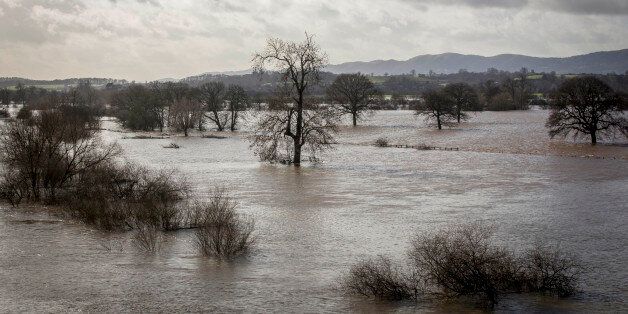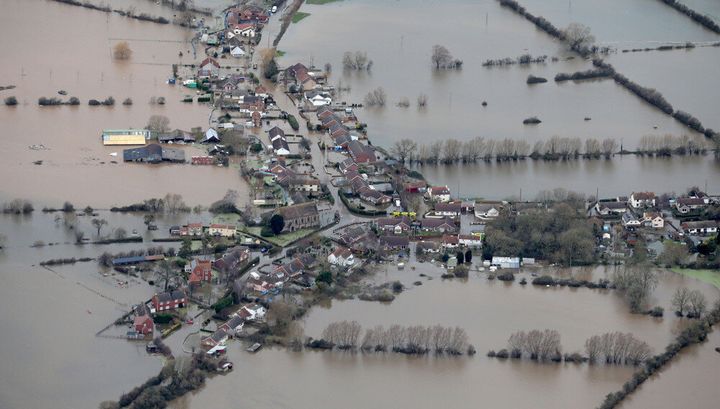
Flooded communities in southern England could be deluged for months, as rivers continue to exercise their "natural sovereignty over flood plains", experts have warned.
Groundwater flooding may remain in some areas south of the Thames Valley from Reading to Salisbury until spring, according to the British Geological Survey.
Underground layers of water-bearing rock - aquifers - in the south of England were half full before the persistent, heavy rain began in mid-December, and have since seen "spectacular" rises in groundwater levels, said hydrogeologist Andrew McKenzie.
Groundwater levels in the Chalk aquifer at Tilshead on Salisbury Plain rose by 20 metres in just two weeks, Mr McKenzie said.
"The very heavy rains over the New Year raised groundwater levels and we got some localised flooding," he said. "But even at that point we weren't sure how widespread that was going to be because there was a lot of empty storage in the aquifers.
"The prolonged rain has just changed the situation totally. We are seeing these extreme rises in groundwater level and that is causing the flood alerts we are seeing. A lot of those are on the Chalk catchment,” the hydrogeologist remarked.

Water surrounds flooded properties in the village of Moorland on the Somerset Levels near Bridgwater
With rains unrelenting since December in some southern parts, Mr McKenzie has said there is “no more capacity” for aquifers to absorb more water.
"If you take the Thames for example, in December the water levels in those sands and gravels was relatively low, the rainfall in December was enough to fill those gravel aquifers, they are now full so there is no more capacity for those aquifers to soak up any more water.
"We don't know how long the rainfall is going to last but what we do know is that there is a very large quantity of water in aquifers.
"What we saw (in the floods) of 2000/2001 was groundwater flooding persisting well into the spring and the last remnants of groundwater flooding finished in about May of 2001.
As many communities struggle to stem the impact of the floods, Mr McKenzie bleakly surmised that some areas are likely to experience “many more months of groundwater issues.”
However, it is believed that such groundwater flooding will only affect localised areas and will not be widespread.
Meanwhile, hydrologist Terry Marsh, of the Centre for Ecology and Hydrology, said that there have been "extreme flows" in some rivers.
"Rivers like the Mole and the Wey have registered probably their highest flows since the damaging floods of 1968," he said.
The River Thames has seen high flows for the longest period since 1883 according to Mr Marsh: "We have seen more extensive flooding (in the past). But what we have seen recently is the whole gamut of flood manifestation, we have seen flash flooding, fluvial flooding, tidal flooding and now increasingly groundwater flooding.
"We are seeing a trend on the Thames, and on other rivers, towards an increased frequency of high flows. The flows are likely to be sustained at a high level for some time because of the groundwater component.
"The Thames will recede. In 2000, flows in the spring were not exceptionally high but again we were still seeing groundwater flooding in places like Henley."
Mr McKenzie remarked: "Certainly with saturated ground and full aquifers it makes the Thames much more responsive to rainfall.
"In terms of the aquifers sustaining flow on the Thames, we're talking about the river gravels alongside the Thames, then we're talking in terms of perhaps weeks going on to months but not multiple months.
"So groundwater flooding on the Chalk might last for two to three months beyond the end of a rainfall event.
"The sustaining of surface flows in a river like the Thames is probably a matter of three to four weeks longer than it otherwise might have been - depending when it stops raining, the disruption will last for weeks."
On an optimistic note, the capacity of the river is 30% greater than in the 1920s. However as communities have become more transient people’s knowledge of flooding is often “sketchy” according to Mr Marsh.
"Communities are so much more mobile than they used to be. When I was young, in villages on the Chilterns there was experience of flooding and this was passed on.
“Nowadays if you go up in the Chilterns the knowledge about groundwater flooding is sketchy.
"Even where you get estates built next to a lane where it floods and that lane is called Watery Lane, the message isn't absorbed."
He concluded: "What we are currently seeing is the Thames exercising its natural sovereignty over its flood plain. This happens occasionally and people should recognise that this happens."
SEE ALSO: